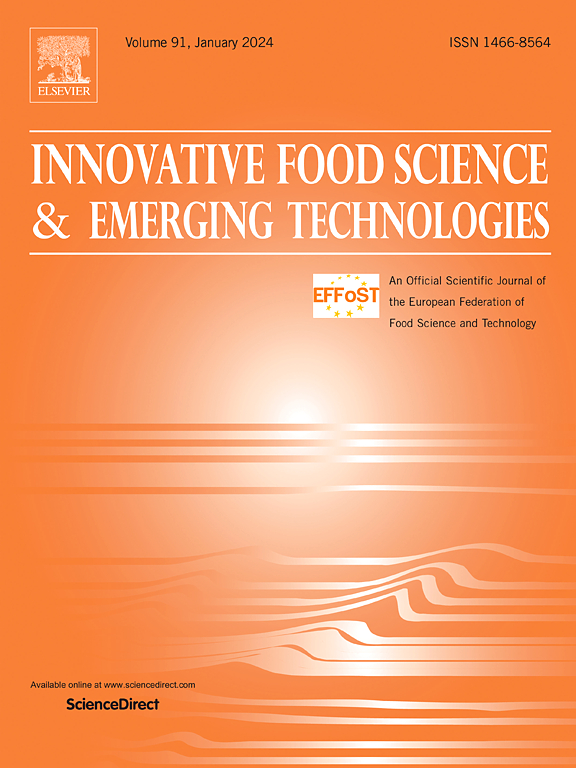欧姆加热辅助预处理龙舌兰甘蔗渣提高生物活性化合物的生物可及性
IF 6.3
1区 农林科学
Q1 FOOD SCIENCE & TECHNOLOGY
Innovative Food Science & Emerging Technologies
Pub Date : 2025-06-06
DOI:10.1016/j.ifset.2025.104076
引用次数: 0
摘要
龙舌兰甘蔗渣是梅兹卡尔生产的副产品,代表着丰富但未充分利用的生物质。本研究采用欧姆加热作为预处理策略,破坏甘蔗渣的顽固性纤维结构,促进生物活性化合物的释放。采用中心复合响应面设计(20次运行)评价水分含量(50 ~ 70%)、电压(100 ~ 120 V)和时间(5 ~ 15 min)三个自变量对总酚含量、可溶性膳食纤维和不可溶性膳食纤维提取的影响。苯酚收率和可溶性纤维的最佳条件为76.33%、107.53 V、7.77 min。在此条件下,欧姆加热显著提高了酚类化合物的提取率和可溶性膳食纤维的比例,同时降低了不溶性膳食纤维的含量。为了评估这些变化的营养相关性,使用标准化的INFOGEST消化模型评估了酚类物质和糖的生物可及性。欧姆加热使单糖的释放增加到222%,表明结构性碳水化合物的有效分解。苯酚的生物可及性提高了252%,与未经欧姆处理的对照样品相比有了显著的提高。虽然酚类化合物的生物可及性在某些加工条件下有所改善,但仍有很大一部分未被消化,这表明在结肠中存在潜在的益生元活性。总的来说,这项研究表明欧姆加热是一项很有前途的绿色技术,可以使龙舌兰甘蔗渣增值,增强其作为生物可及化合物来源的功能,并支持其纳入可持续的、健康导向的食品应用。本文章由计算机程序翻译,如有差异,请以英文原文为准。
Ohmic heating-assisted pretreatment of agave bagasse to increase bioactive compounds bioaccessibility
Agave bagasse, a byproduct of mezcal production, represents an abundant yet underutilized biomass. In this study, ohmic heating was applied as a pretreatment strategy to disrupt the bagasse's recalcitrant fiber structure and enhance the release of bioactive compounds. A central composite response surface design (20 runs) was used to evaluate the effects of three independent variables, moisture content (50–70 %), voltage (100–120 V), and time (5–15 min), on the extraction of total phenolic content, soluble dietary fiber, and insoluble dietary fiber. The optimal conditions for maximizing phenolic yield and soluble fiber were 76.33 % moisture, 107.53 V, and 7.77 min of treatment. Under these conditions, ohmic heating significantly increased the extraction of phenolic compounds and the proportion of soluble dietary fiber, while reducing the content of insoluble fiber. To evaluate the nutritional relevance of these changes, the bioaccessibility of phenolics and sugars was assessed using the standardized INFOGEST digestion model. Ohmic heating increased the release of simple sugars up to 222 %, indicating effective breakdown of structural carbohydrates. Phenolic bioaccessibility increased up to 252 %, a substantial increase compared with the control sample without ohmic treatment. Although the bioaccessibility of phenolic compounds improved for certain processing conditions, a significant fraction remained undigested, suggesting potential prebiotic activity in the colon. Overall, this study demonstrates that ohmic heating is a promising green technology for the valorization of agave bagasse, enhancing its functionality as a source of bioaccessible compounds and supporting its incorporation into sustainable, health-oriented food applications.
求助全文
通过发布文献求助,成功后即可免费获取论文全文。
去求助
来源期刊
CiteScore
12.00
自引率
6.10%
发文量
259
审稿时长
25 days
期刊介绍:
Innovative Food Science and Emerging Technologies (IFSET) aims to provide the highest quality original contributions and few, mainly upon invitation, reviews on and highly innovative developments in food science and emerging food process technologies. The significance of the results either for the science community or for industrial R&D groups must be specified. Papers submitted must be of highest scientific quality and only those advancing current scientific knowledge and understanding or with technical relevance will be considered.

 求助内容:
求助内容: 应助结果提醒方式:
应助结果提醒方式:


